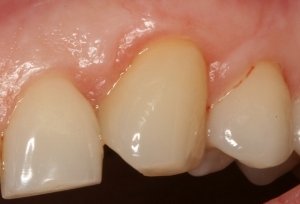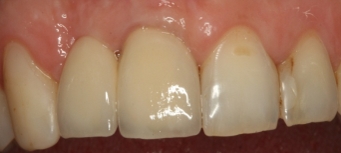Gingival grafting

It is a paradox but the most common cause for gingival recession is teeth cleaning. To be more exact, incorrect cleaning, i.e. too strong abrasion of labial dental surfaces and gums by horizontal movements of a toothbrush. Improper use of electrical toothbrushes is particularly harmful. It damages both dental enamel and gums. Dental gums which protrude most towards the lips are the ones which suffer most often, especially the gums of canine teeth. When the oral hygienist teaches patients to maintain oral cavity properly and without any harm, gums stop receding from dental necks, yet they do not reach the former level.
When open dental roots are sensitive to cold food, i.e. impede normal eating, sensitivity cannot be reduced by any special means or they are very exposed when speaking, smiling, gingival grafting procedure is required. Gums are transplanted from the palate or special artificial materials (membranes) are used.
 |
 |
|
Sensitive and non-aesthetic neck of the canine tooth |
After gingival grafting |
Another common cause due to which gingival grafting is required is dental implants. In the majority of cases gums are grafted along with implantation in the area of incisors because otherwise it is complicated to create a natural ratio of dental crown and gums.
 |
 |
|
Gums were not grafted during implantation, i.e. ceramic gums were fabricated |
Naturally grafted gums |
 |
|
|
Exposed necks of dental implants
|
Moreover, when the so-called fixed gums (which are stable at implants when lips and tongue move) are not created around implants placed anywhere in the mouth, in the long run, implant necks become exposed and inflammation (peri-implantitis) can develop: the moving labial, buccal or lingual mucosa pulls unstable gums away from the surface of implants and “pumps” food residues under it. Lack of fixed gums is one of the most common causes for dental implant loss.
specialists Contacts Doctor's appointment


